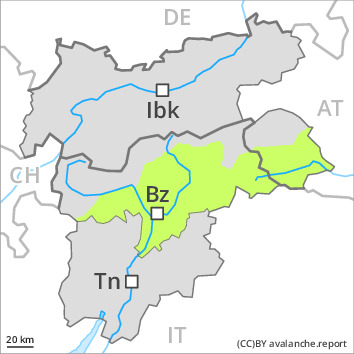
Danger level
 | 2400m |
|  |
|  |

Fresh and older wind slabs require caution.
A generally favourable avalanche situation will prevail. Wind slabs represent the main danger. Avalanche prone locations for dry avalanches are to be found in particular adjacent to ridgelines above approximately 2400 m and in the vicinity of peaks. The avalanche prone locations are easy to recognise.
Dry avalanches can additionally in very isolated cases be released in deep layers by large loads. This applies in particular on extremely steep northwest, north and northeast facing slopes above approximately 2400 m in areas where the snow cover is rather shallow, also on extremely steep sunny slopes in particular above approximately 2800 m. The number and size of avalanche prone locations will increase with altitude.
In some cases avalanches are medium-sized.
In steep terrain there is a danger of falling on the hard crust.
Snowpack
dp.6: cold, loose snow and wind
The wind slabs of the last few days have bonded quite well with the old snowpack. As a consequence of the occasionally strong westerly wind, fresh snow drift accumulations will form during the next few days. These are mostly small and in some cases prone to triggering.
The snowpack will be subject to considerable local variations. In very isolated cases weak layers exist in the centre of the old snowpack. This applies in particular above approximately 2400 m. Above the tree line snow depths vary greatly, depending on the infuence of the wind. On sunny slopes below approximately 2200 m only a little snow is now lying.
The snowpack is moist and its surface has a melt-freeze crust. This applies on sunny slopes and at low and intermediate altitudes.
Tendency
A generally favourable avalanche situation will prevail. The wind will be strong in some localities.


